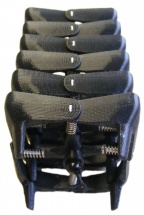 A team of engineers at Clemson University, led by Michael M. Porter, have created a 3-D printed model of a seahorse’s tail in the hopes of finding out if the tail’s unique shape – an organization of square prisms surrounded by bony plates that are connected by joints – has a functional advantage over the cylindrical tails that most animals possess. After the scientists created 3-D models of a square prism and a cylindrical tail, they whacked the models with a rubber mallet and twisted and bent them. The findings? The square was stiffer and more resilient when crushed, and was half as able to twist, a feature which could help prevent damage and supply greater control.
A team of engineers at Clemson University, led by Michael M. Porter, have created a 3-D printed model of a seahorse’s tail in the hopes of finding out if the tail’s unique shape – an organization of square prisms surrounded by bony plates that are connected by joints – has a functional advantage over the cylindrical tails that most animals possess. After the scientists created 3-D models of a square prism and a cylindrical tail, they whacked the models with a rubber mallet and twisted and bent them. The findings? The square was stiffer and more resilient when crushed, and was half as able to twist, a feature which could help prevent damage and supply greater control.
The seahorse tail could inspire new types of armor, or even search-and-rescue robots that would move like a snake and contract to fit into tight spaces. I’m looking forward to hearing more about this fascinating discovery; it has the potential to inspire breakthroughs in robotics, defense systems, or even biomedicine.
https://youtu.be/Isy4Bk4jako










0 Comments